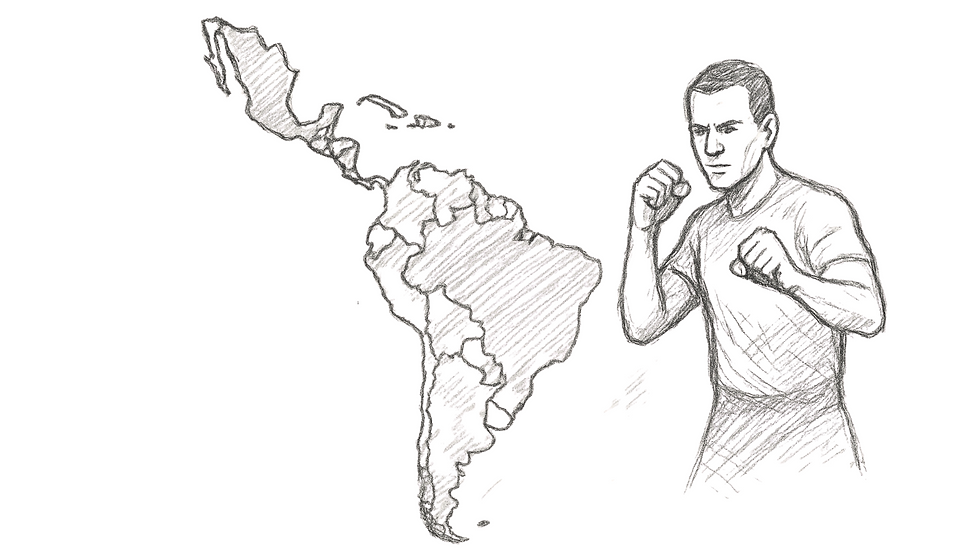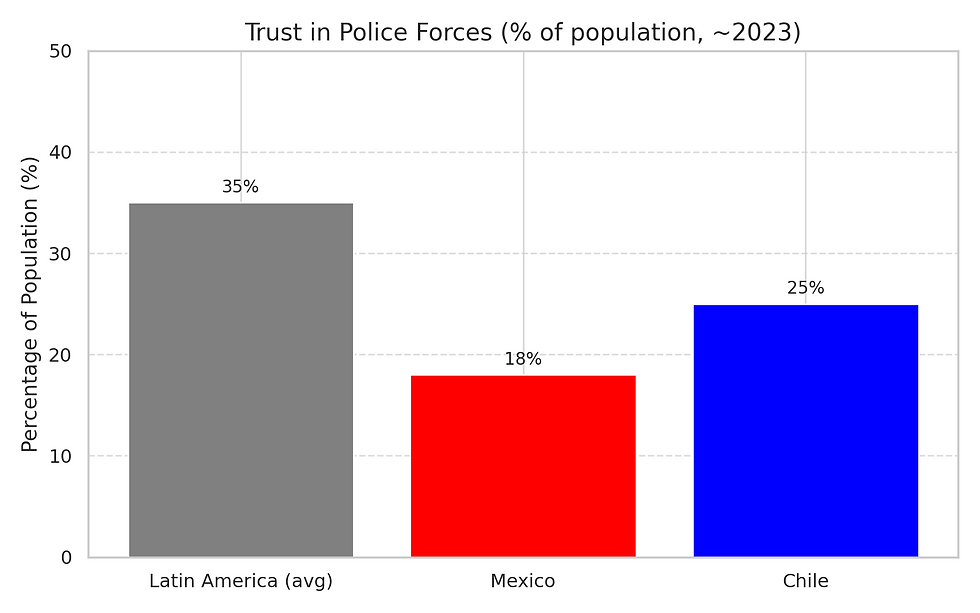Why Latin America Matters: Culture, Conflict, and the Need for Real Protection
- Ilya Dunsky

- Jul 26
- 6 min read

Latin America is not a monolith. It is a vast and breathing continent of many voices where stories are sung as often as they are spoken. From the volcanic highlands of Guatemala to the bustling streets of Mexico City, through the wide rivers of Colombia, the dense forests of Brazil, the windswept mountains of Peru, and the restless urban heart of the Southern Cone.
Every corner in Latin America hums with llife.
In latin world, resistance is rhythm. Capoeira spins barefoot in the plazas of Bahia. Poetry drifts through the cafés of Buenos Aires. Andean rituals keep time with the earth, while protest songs echo in the streets of Chile. It is a region that moves through music, through language, through struggle. Proud, diverse, and fiercely alive.
Nevertheless, beneath the surface of this celebration runs a quieter pulse, one of caution, grief, and vigilance. Too often, life is lived between beauty and brutality. Families measure their days not only by joy but by risk: which bus to take, which street to avoid, how loudly to speak, and who might be listening.
Violence, in many places, is not distant. It is the backdrop to childhoods, to daily commutes, to the simple act of walking home. And those tasked with defending the public, the police , are often caught in the same trap. Underfunded, overworked, and mistrusted, many officers patrol with too little training and too much fear. Civilians and security forces alike are left navigating a cycle that neither of them controls: a cycle of violence, silence, and survival.
A Region Under Pressure
In 2023, Latin America and the Caribbean recorded over 121,000 homicides, with a regional median of 20.2 per 100,000 people more than double the global average (Insight Crime, 2025). The causes vary: organized crime, weak institutions, poverty, political instability. But the result is the same: fear.

As the chart above shows, homicide rates remain critically high in countries like Brazil (27), Colombia (26.1), and Mexico (24.9). These aren’t just numbers. They reflect fragile communities, overwhelmed systems, and daily decisions made out of survival. Even countries with traditionally lower violence like Chile and Argentina are experiencing troubling trends.
Chile: A Warning from the South
Chile has long been considered one of the more stable countries in the region. But even there, the cracks are widening. Over the last decade, its homicide rate has tripled, rising from 3.3 in 2013 to over 10 in 2023 (Financial Times, 2025).

This trend is alarming not just because of the numbers, but because of what it reveals: no country is immune. When crime networks expand, when state institutions fail to adapt, violence follows and it can grow rapidly.
The Hidden War Against Women
Street violence dominates headlines, but for women across Latin America, the most dangerous place can be their own home. In 2023, at least 3,897 femicides were officially recorded, meaning nearly 11 women murdered per day for gender-related reasons (ECLAC, 2023). Many had already sought help but sadly most were failed by the system.

Mexico alone registered 852 femicides, while Argentina saw 322 cases its a 33% rise compared to the year before (Insight Crime, 2024; The Guardian, 2024). In Brazil, hospitalizations from intimate partner violence remain alarmingly high (IPEA, 2023). These deaths are not random. They are systemic failures thya often predictable, often preventable.
And justice rarely comes. In several countries, the impunity rate for femicide exceeds 90% (UN Women, 2024). Behind each statistic is a name, a face, a community in mourning.
A Crisis of Trust
Violence thrives where trust breaks. And in much of Latin America, trust in the police has fractured nd dangerously so. According to Latinobarómetro, only 35% of Latin Americans say they trust their police forces. In Mexico, that number drops dramatically to under 18% (INEGI, 2023). Even in Chile, where the image of order once defined the national identity, confidence has crumbled. Police reform has stalled following allegations of widespread abuses during the 2019 protests (Amnesty International, 2022).

This graph makes the gap starkly visible. It places the regional average alongside two key countries: Mexico, where public trust is nearly nonexistent, and Chile, which has seen its own decline after recent unrest. The separation isn’t just visual, it tells a story. Mexico represents a breakdown. Chile, a warning. The regional average stands as a fragile midpoint in a continent wide crisis of confidence.
But police officers are not always the villains in this story. Many serve under crushing conditions: low pay, poor training, institutional neglect, and daily danger. In El Salvador, officers have come forward about being pressured into unjust arrests and operating under arbitrary quotas, caught between crime and politics (Human Rights Watch, 2025).
The result is a vicious cycle. Civilians don’t trust the institutions meant to protect them. Officers feel unsupported and abandoned. Both operate in fear. And neither alone can break the cycle.
Why Training Matters
Krav Maga was developed for situations exactly like this. It was designed not for tournaments but for survival. It teaches people how to deal with violence under stress, how to make decisions quickly, and how to protect themselves and others when no one else will.
For civilians, Krav Maga builds clarity and confidence. It offers people of all backgrounds practical skills to defend themselves, whether from street threats, home invasions, or personal assault. It does not rely on strength or speed, but on awareness, mindset, and strategy.
For women, Krav Maga can be transformational. It helps survivors rebuild their sense of agency and helps at risk individuals feel less helpless in the face of real threats. The training is not just physical. It is emotional and mental.
For police officers, Krav Maga offers techniques that are adaptable to the real conditions of the job. It emphasizes control, deescalation, and responsible use of force. It trains officers to act without freezing, without escalating unnecessarily, and without needing to resort to lethal options in every encounter.
And for instructors, Krav Maga becomes more than a method. It becomes a mission. In communities where people feel abandoned or afraid, instructors become local leaders, people who can offer not just techniques but hope, stability, and presence.
Looking Ahead
From September 3rd to 7th, 2025, certified Krav Maga instructors from across Latin America will gather in Montevideo for the ID Krav Maga Instructor Conversion Course. This five-day intensive training is designed for instructors from other systems who want to join ID Krav Maga’s approach without starting over from scratch.
Continue to the conversion course, on September 6th, also in Montevideo, we will hold a Shooting Seminar open to both law enforcement personnel and certified instructors. This event focuses on function under fire: how to operate with precision, restraint, and tactical awareness under real stress. Because it’s not just about how you shoot t’s about how you think, react, and protect life in the moments that matter most.
The goal is to build something lasting. Something rooted in clarity, realism, ethics, and results. Something that helps people face the challenges of this region with preparation, not panic.
This is the beginning of a project very close to my heart and a personal mission to make Latin America safer, so we can all smile and dance knowing that we can protect others and ourselves. Be part of it.
Stay strong, stay safe, and always be prepared.
-----
Disclaimer:
The statistics and data presented in this blog post were sourced from reputable newspapers, international organizations, and official government census reports, as cited throughout the article. All graphs and visual materials were created by the author based on an independent interpretation of this publicly available data. While every effort has been made to ensure accuracy, the analysis and commentary reflect the author's personal understanding and should not be considered official statements from the original data sources.
References
Insight Crime 2025, “2024 Homicide Round Up”
Financial Times 2025, “Chile’s Rising Crime Wave”
UN OHCHR 2024, “Colombia: Massacre Reports and State Response”
Reuters 2024, “Argentina Crime Statistics and Rosario Violence”
GIS Reports 2025, “Ecuador Organized Crime and Homicides”
ECLAC 2023, Gender Equality Observatory: Femicide Report
UN Women 2024, Regional Gender Based Violence Brief
IPEA 2023, Brazil Public Safety Report
Human Rights Watch 2025, “El Salvador Police and Human Rights Violations”
Latinobarómetro 2023, Public Trust in Institutions
INEGI 2023, National Victimization Survey:
Mexico
Amnesty International 2022, “Chile’s Carabineros and Protest Repression”






